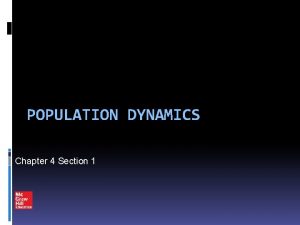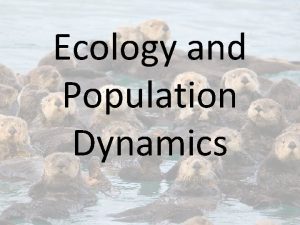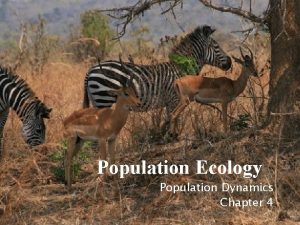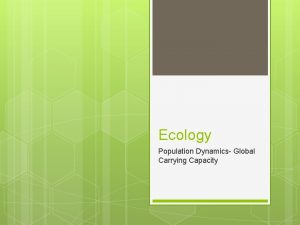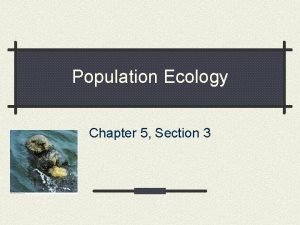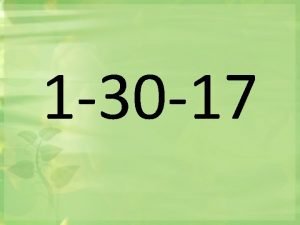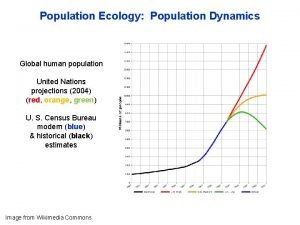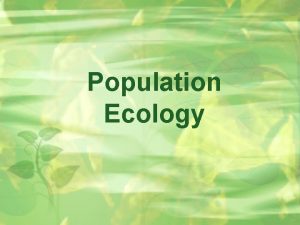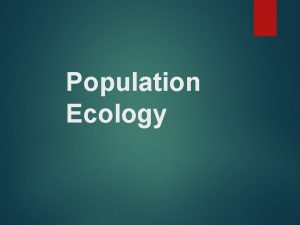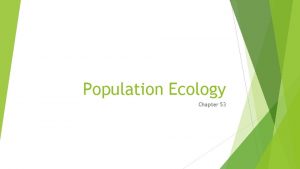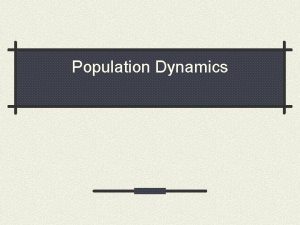Chapter 5 Population Ecology Section 1 Population Dynamics






















- Slides: 22

Chapter 5: Population Ecology

Section 1: Population Dynamics CLE 3210. 2. 2: Analyze and interpret population data, graphs, or diagrams. Objectives: Describe characteristics of populations; Understand the concepts of carrying capacity and limiting factors; Describe the ways in which populations are distributed.

Population Characteristics l All species occur in groups called populations l There are certain characteristics that all populations have: l Population Density l Population density is the number of organisms per unit area

l Spatial Distribution l The pattern of population spacing in an area l 3 Main Types: 1. Uniform Dispersion evenly spaced; black bear 2. Clumped Dispersion clustered together; herds 3. Random Dispersion randomly arranged; deer


l Population Ranges l How far can a species spread? What areas can a species survive in? l No population can survive in all habitats. l Populations are limited by biotic and abiotic factors l. A species might not be able to expand its population range because it cannot survive the abiotic and biotic factors found in the expanded region.

Population-Limiting Factors l Limiting factors keep a population from continuing to increase forever

l Density-Independent Factors l Factors that do not depend on population size; will occur whether or not living things are present l Usually abiotic l Ex: Extreme hot or cold, tornadoes, hurricanes

l Density-dependent factors l An environmental factor that depends on population size l Usually biotic factors l Ex: predation, disease, parasites, competition

l Disease l Outbreaks of disease tend to occur when population size has increased and population density is high…disease is passed easily from one organism to another

l Competition between organisms increases when density increases l When the population increases to a size where resources (food, space) become limited, individuals must compete for the resources

l Parasites l Affects organisms similar to disease…higher density populations will be negatively affected by parasites (will decrease numbers)

Population Growth Rate l Explains how fast a population grows l Must know birth rate (natality) and death rates (mortality ) l Emigration: how many leave (“EXIT”) l Immigration: how many move in

Exponential Growth l Occurs when the growth rate is proportional to the size of the population

Logistic Growth Model l Occurs when the population’s growth slows or stops; reaches carrying capacity

Carrying Capacity Maximum number of a species that an environment can support l Limited by energy, water, oxygen, and nutrients l

Reproductive Patterns l Both plants and animals are placed into groups based on their reproductive factors r-strategists: generally small organisms that have short life spans and produce many offspring (fruit fly, mouse, locusts) l k-strategists: larger organisms with longer life spans that produce only a few offspring (humans, lions, elephants) l

Section 2: Human Population CLE 3210. 2. 1: Investigate how the dynamic equilibrium of an ecological community is associated with interactions among its organisms Objectives: Explain the trends in human population growth; Compare the age structure of representative nongrowing, slowly growing, and rapidly growing countries; Predict the consequences of continued population growth

Human Population Growth l Demography study of population size, density, distribution, movement, and birth and death rate

In 1804, the population of Earth was an estimated one billion people l By 1999, the human population had reached six billion people. l At this growth rate, about 70 million people are added to the world population annually and the world’s population is expected to double in about 53 years. l

1 in 7 Billion

l Technological advances have increased human carrying capacity l Ex: agriculture, medicine, shelter
 Section 1 population dynamics answer key
Section 1 population dynamics answer key Population ecology chapter 4 answers
Population ecology chapter 4 answers Section 1 population dynamics answer key
Section 1 population dynamics answer key Population ecology section 1 population dynamics
Population ecology section 1 population dynamics Chapter 4 section 1 population dynamics
Chapter 4 section 1 population dynamics Chapter 4 population ecology answer key
Chapter 4 population ecology answer key Chapter 53 population ecology
Chapter 53 population ecology Chapter 36 population ecology
Chapter 36 population ecology Chapter 4 population ecology answer key
Chapter 4 population ecology answer key Chapter 53 population ecology
Chapter 53 population ecology Chapter 53 population ecology
Chapter 53 population ecology Study guide chapter 3 section 1 community ecology
Study guide chapter 3 section 1 community ecology Chapter 2 principles of ecology
Chapter 2 principles of ecology Principles of ecology chapter 2 section 1 answer key
Principles of ecology chapter 2 section 1 answer key Chapter 2 principles of ecology
Chapter 2 principles of ecology Chapter 2 section 1 organisms and their relationships
Chapter 2 section 1 organisms and their relationships Clumped dispersion
Clumped dispersion Logistic and exponential growth
Logistic and exponential growth Population vs community ecology
Population vs community ecology Ecosystem vs community
Ecosystem vs community Concept 3 population ecology
Concept 3 population ecology Population ecology def
Population ecology def Population characteristic
Population characteristic




